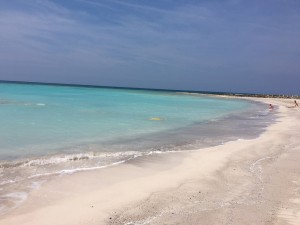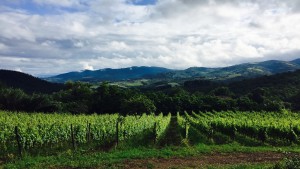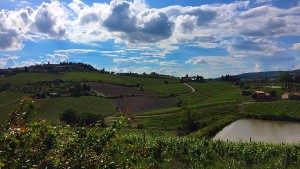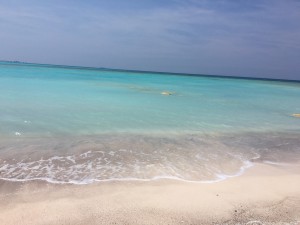Introduction:
Tourism is a controversial topic. On one hand tourism helps the area through increasing economic activities, while on the contrary, tourism exploits the culture and land. It is not strange that tourists would have a particular image and assumption of where he or she visits. As a result, to cater to their presumption image of the land, some places would change the landscape and environment so that the area can match what the tourists would want to see. In a sense, the process of changing the landscape to match the idealistic image is beautifying the land. However, it comes with a price. Countless numbers of violence have been done to the land, which includes animals and plants. There is a thin line between using violence to improve the land and harming the land, and this line needs to be observed and monitored closely.
Panzano: the ‘Golden Valley.’
Panzano is a small town that is located in the region of Chianti in Tuscany. The region of Chianti is known for its wines, especially the Chianti Classico wine. Despite being in a region that is known for the production of a particular type of wine, Panzano’s nickname used to be the ‘Golden Valley’ before the landscape changes. The reason why the town was given the nickname is that in the past, wheat was the main crop. During the harvest season, the wheat would have changed the color of the green valley into a deep gold color. As a matter of fact, Chianti used to be a significant producer of gains up until around the nineteenth century. A.M. Baldini mentions that
“One of the most productive areas for wheat was, in fact, the Conca d’Oro of Panzano, and as harvest time approached it was exactly what the name says, a golden basin of ripening wheat. It was only post-war years that wheat was replaced by the increasingly lucrative crop yielding olive oil and wine” (Baldini, Baldini and profile).
It is interesting that the crops transitions from wheat to olives and grapes because it represents the transition growing certain crops because they are necessary to grow certain crops because the will eventually yield more profit. Not only do the grapes, and the olives can be sold for more than the wheat when they are harvested, but the process of turning them into wines and olive oils can increase their net worth substantially.
Another reason to why these certain crops bring in more profit is that they cater and match the tourist opinion of Tuscany and Chianti. Dr. Martino Danielli, a naturalist, raises the points that, “The Chianti wine became very famous by the late ’80s and many more fields have been changed in the vineyard. Before that in Panzano in Chianti, farmers produced many more cereals, fruit and oil and the landscape was more varied” (Martino Danielli). Due to the popularity of the Chianti wines, the wineries have to expand and convert the land so that they can accommodate the demanding market.
The increase in the popularity of the wines attracts the tourist to come and visit the area. Some people tend to have a mental conception of what Chianti is supposed to look like. Usually, that will be of endless rows of vineyards and olive trees. This preconceived notion of what Chianti can affect its economic. This is because it will influence the tourists’ desire to visit and to see the landscape. However at the same time, if the real image of Chianti does not match the tourists’ mental image of Chianti, it might cause them not wanting to go back and in the process, decrease the tourist activity in Chianti. By having this knowledge, the landscapes are altered to correspond the desired image.
‘Baking Soda’ Beach
Even though most beautification processes are intentional, in some cases, it can be an unintentional result. Near the city of Castiglioncello, there is a long stretch of beach that looks magnificent. Spiagge Bianche (the white beach) or also known as the ‘Baking Soda’ beach is a beach that has fine white sand and turquoise water. The reason why this beach has a breathless view is that of the byproduct of the baking soda plant that is close to the beach’s vicinity. The addition of the baking soda is changing the water color from a deep ocean blue into a cloudy turquoise, and the white sand is coated with dustings of baking soda.
As of right now, it is uncertain if the baking soda is affecting the ocean ecology in a  negative way, but one thing for sure is that the beach looks breathtaking. The beach appearance has lure many visitors and tourists to visit the beach. The idea of being on the beach that is covered with fine white sand and amazing color water is tempting to most people. Spiagge Bianche is a rare case of which the unintentional beautification of the land triggers the influx of tourists and not the other way around, which is tourism triggering the beautification process of the land.
negative way, but one thing for sure is that the beach looks breathtaking. The beach appearance has lure many visitors and tourists to visit the beach. The idea of being on the beach that is covered with fine white sand and amazing color water is tempting to most people. Spiagge Bianche is a rare case of which the unintentional beautification of the land triggers the influx of tourists and not the other way around, which is tourism triggering the beautification process of the land.
Violence on the Land
When dealing with nature, especially changing the landscape, there is always an act of violence on the land itself. A simple trimming of the brown leaf is also considered to be an act of violence because the person is physically severing a part of the plant, hence hurting the plant even if the person is trimming the plant with the purpose of trying to take care of the plant. “Taking care in Greek is called therapeuma, The farmer cares for the living at the same time as the does its violence… The farmer, therefore, his tools and his technical knowledge: he cultivates an art of working the land… which is also violence against the land” (Stiegler, 2). In the very beginning of every farmland, the farmer needs to perform a violent act against the land so that he or she can sow the land. The farmer would tear up and turn over the land to plants the seeds or to create space for his or her animal barns.
In the case of Panzano, the initial act of violence was to plant and grow the wheat, then the next act of violence is to clear the grain field to plant and grow the grapes and the olives. Unfortunately, violence does not end there. Plants receive violent treatment from the farmers on a daily basis. For example, the farmers often cut the grape leaves so that the grape can get and store more sugar. In the farmer’s perspective, he or she is trying to take care of the plant and trying to get the best crop. On the other hand, the farmer is harming the plant because the cut is unnecessary since the plant can still survive without the intervention.
The violence that is done on the Spiagge Bianche is much more extreme than the violence that is being done to farmland. On land, the violence is contained to certain areas, like a farm, whereas in the ocean, what started out in a tiny spot can spread out and will eventually affect the entire ocean. Baking soda, calcium carbonate, is widely used for cooking and baking in a small amount. In small amount, it can benefit us, but in large industrial quantity, it can harm the environment. “Although calcium carbonate is a base… our ocean is becoming a little bit more like vinegar… As the oceans become more acidic, the concentrations of carbonate ions available will decrease. This will make it harder for some species to build their shells and skeletons… in more extreme cases… their shells may begin to dissolve” (“Basic Needs: A Report On Ocean Acidification | Oceans At MIT”). It is never good to have something in excess, and this proves the statement. Baking soda is widely used in household remedies, but at the same time, it can be deadly for the ecological system.
Conclusion
There is no doubt that the landscapes have changed throughout times with and without human interactions. For a period, humans have only sped up the rate of the change and influenced what kind of changes happened. After the transition from being hunter and gatherers to farmers, people have learned to use and cultivate the land to their advantage.They still use this advantage today through the beautification of the land to bring in more tourists to their area. Tourism and the beautification of the land go hand in hand. They have a parallel relationship which when one increases; the other will increase as well.
As the dynamic between the two of the grows, violence towards the land is unavoidable. The acts of violence in agriculture are necessary to sustain the human population and the plant’s health up to a point. In both cases of Panzano and the beach, the beautification of the land has resulted in human giving the environment a violent treatment. While the change in landscape for Panzano does not harm the environment much, the beach’s ecological system could soon be destroyed because of the by-product that is being emitted by the baking soda manufactory. As cultivators of the lands, we should pay more attention to the health of the land and to not take advantage of it.
Bibliography
- Baldini, Anna, Anna Baldini, and View profile. “Tuscany 2016 – Things To See And Do When You Visit Tuscany: Why Is The Conca D’oro Of Panzano In Chianti Called The Conca D’oro?”. Tuscany-toscana.blogspot.it. N.p., 2013. Web. 16 June 2016.
- “Basic Needs: A Report On Ocean Acidification | Oceans At MIT”. Oceans.mit.edu. N.p., 2016. Web. 16 June 2016.
- Danielli, Martino, June 16th 2016.
- Stiegler, Bernard, Take Care.



